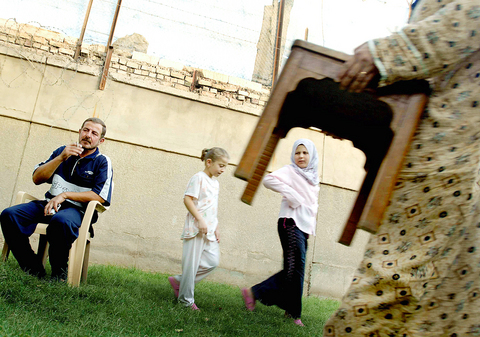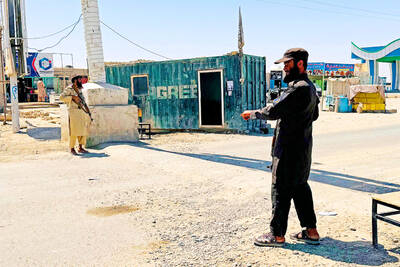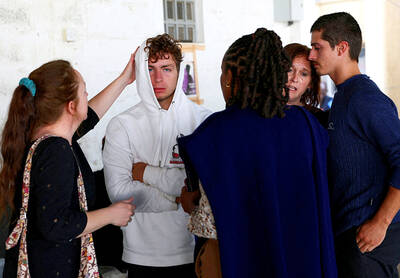Iraqis call it Assur, the Fence. In English everyone calls it the Wall, and in the past two years it has grown and grown until it has become an almost continuous rampart, at least 16km in circumference, around the seat of US power in Baghdad.
The wall is not a small factor in the lives of ordinary Iraqis outside it. Khalid Daoud, an employee at the Culture Ministry, still looks in disbelief at the barrier of 3.6m high five-tonne slabs that cuts through his garden.
This is one snapshot of life for countless Iraqis who live, work, shop and kick soccer balls around in the shadow of the structure. Many despise the wall, a few are strangely drawn to it, but no one can ignore it. Fortifications of one kind or another abound in the city, but there is nothing that compares to the snaking, zigzagging loop that is the wall.

PHOTO: NY TIMES NEWS SERVICE
Sometimes likened to the Berlin Wall by those who are not happy about its presence, the structure cleanly divides the relative safety of the Green Zone, which includes Saddam Hussein's old palace and ministry complex, now used by the US authorities and heavily patrolled by US troops, from the Red Zone -- most of the rest of Baghdad -- where security ranges from adequate to nonexistent.
But for all the problems faced by residents across the city, the neighborhoods within a few blocks of the wall have become a world apart. Mortar rounds and rockets fired at the Green Zone fall short and land there. Suicide bombers, unable to breach the wall, explode in shops just outside it. And the maze of checkpoints, blocked streets and rumbling US armor may be thicker here than anywhere else in Baghdad.
"We are the new Palestine," said Saman Abdel Aziz Rahman, owner of the Serawan kebab restaurant, hard upon the northern reaches of the wall.
Two weeks ago a man walked into a restaurant a few doors from the Serawan and blew himself up at lunchtime, killing 23 people, wounding 36 and sending pieces of flesh all the way to Rahman's establishment.
One of the paradoxes of the wall is that while many are repelled by it, others are drawn by the feeling that they will be protected by the overwhelming might that lies just on the other side. US foot patrols, rarely seen elsewhere in Baghdad, are fairly routine along the outside of the wall, and residents know that any sustained guerrilla incursion near the zone would draw a swarm of Apache helicopters and Humvees, as well as a tank or two if necessary.
The stretch of wall near the Serawan, which is faced with a stucco-like material, is not new. It is there that the wall encloses the Assassin's Gate, the bulky arch above a boulevard leading to Saddam's former Republican Palace. Even though the Americans doubled its height with a chain-link fence, barbed wire and a green tarpaulin on top, there is little sense that the structure has blighted the neighborhood.
Soad Harb, an engineer who lives with her family next to the July 14th Bridge in a well-appointed apartment that senior officials in Saddam's government abandoned in 2003, said she was happy to live so close to the southern boundary of the Green Zone, where she sometimes finds work with Fluor, a big US contractor.
Harb said that while the US checkpoint at the end of the bridge made the neighborhood dangerous and noisy, the soldiers who walked through the area talking with children made the barrier seem less intimidating.
But the same cannot be said in the middle-class district of Harithiya, just beyond the western edge of the Green Zone, where the great concrete slabs arrived about two months ago.
Sometimes called blast walls because the steel reinforcing inside is designed to withstand explosions, the slabs are a looming, sinister presence facing a long line of family homes from across Al-Shawaf Street in Harithiya.
Haider al-Shawaf, a 35-year-old businessman who grew up here, first described the unpleasantness of the wall with a crude US expression. Then, as helicopters clattered to and fro overhead, Shawaf said nervously, "I am afraid of the Americans here -- afraid of this wall."

‘EYE FOR AN EYE’: Two of the men were shot by a male relative of the victims, whose families turned down the opportunity to offer them amnesty, the Supreme Court said Four men were yesterday publicly executed in Afghanistan, the Supreme Court said, the highest number of executions to be carried out in one day since the Taliban’s return to power. The executions in three separate provinces brought to 10 the number of men publicly put to death since 2021, according to an Agence France-Presse tally. Public executions were common during the Taliban’s first rule from 1996 to 2001, with most of them carried out publicly in sports stadiums. Two men were shot around six or seven times by a male relative of the victims in front of spectators in Qala-i-Naw, the center

Incumbent Ecuadoran President Daniel Noboa on Sunday claimed a runaway victory in the nation’s presidential election, after voters endorsed the young leader’s “iron fist” approach to rampant cartel violence. With more than 90 percent of the votes counted, the National Election Council said Noboa had an unassailable 12-point lead over his leftist rival Luisa Gonzalez. Official results showed Noboa with 56 percent of the vote, against Gonzalez’s 44 percent — a far bigger winning margin than expected after a virtual tie in the first round. Speaking to jubilant supporters in his hometown of Olon, the 37-year-old president claimed a “historic victory.” “A huge hug

Two Belgian teenagers on Tuesday were charged with wildlife piracy after they were found with thousands of ants packed in test tubes in what Kenyan authorities said was part of a trend in trafficking smaller and lesser-known species. Lornoy David and Seppe Lodewijckx, two 19-year-olds who were arrested on April 5 with 5,000 ants at a guest house, appeared distraught during their appearance before a magistrate in Nairobi and were comforted in the courtroom by relatives. They told the magistrate that they were collecting the ants for fun and did not know that it was illegal. In a separate criminal case, Kenyan Dennis

The US will help bolster the Philippines’ arsenal and step up joint military exercises, Manila’s defense chief said, as tensions between Washington and China escalate. The longtime US ally is expecting a sustained US$500 million in annual defense funding from Washington through 2029 to boost its military capabilities and deter China’s “aggression” in the region, Philippine Secretary of Defense Gilberto Teodoro said in an interview in Manila on Thursday. “It is a no-brainer for anybody, because of the aggressive behavior of China,” Teodoro said on close military ties with the US under President Donald Trump. “The efforts for deterrence, for joint resilience